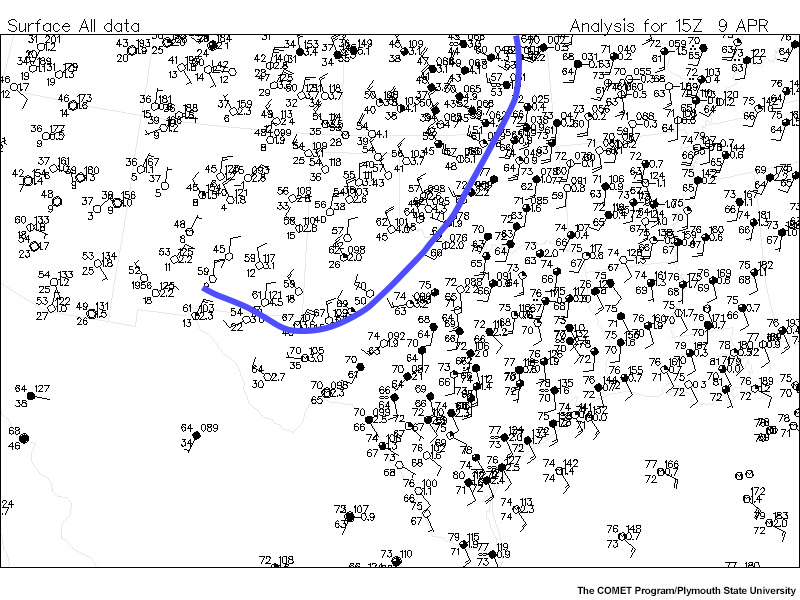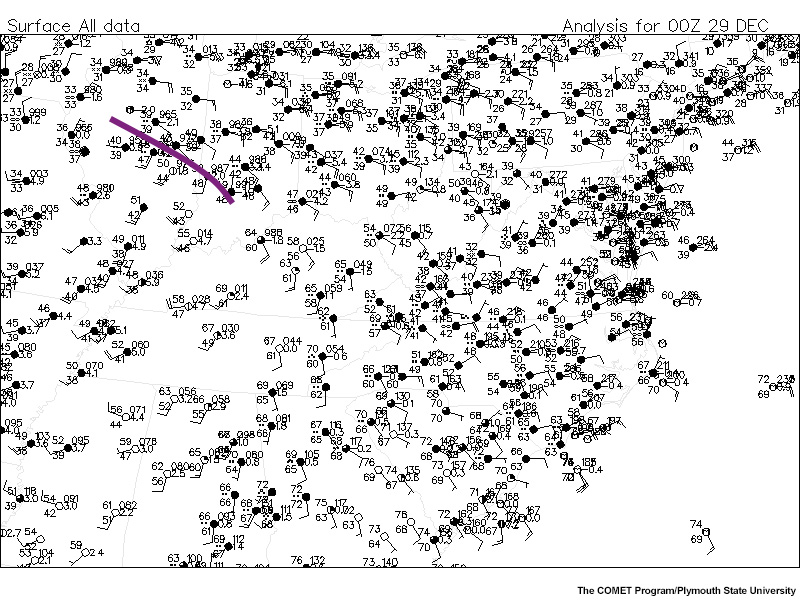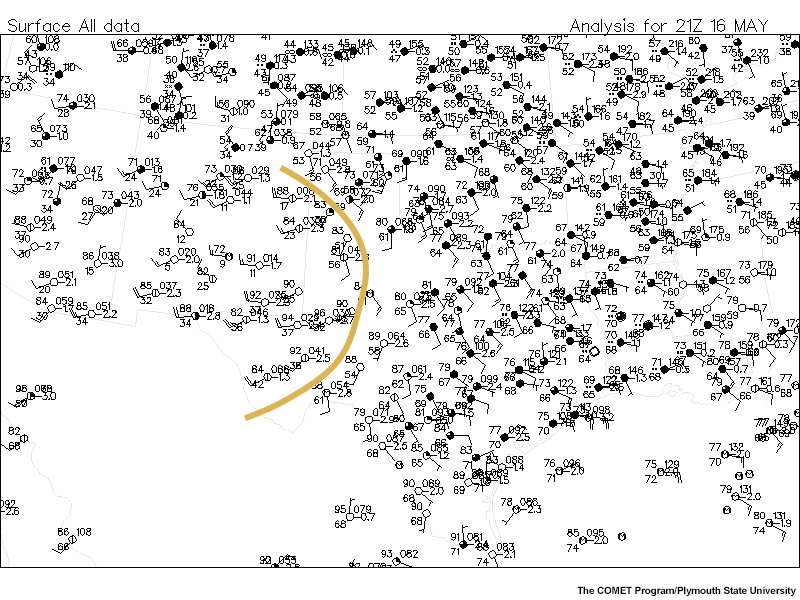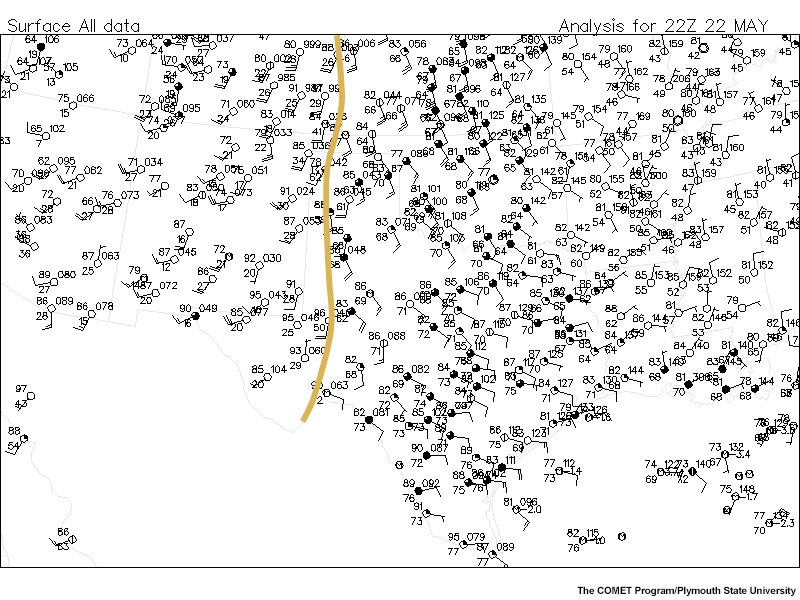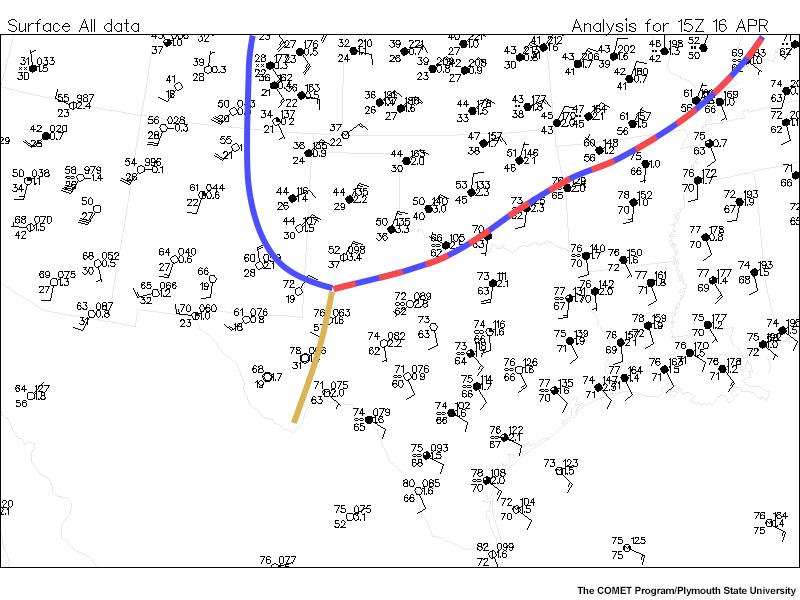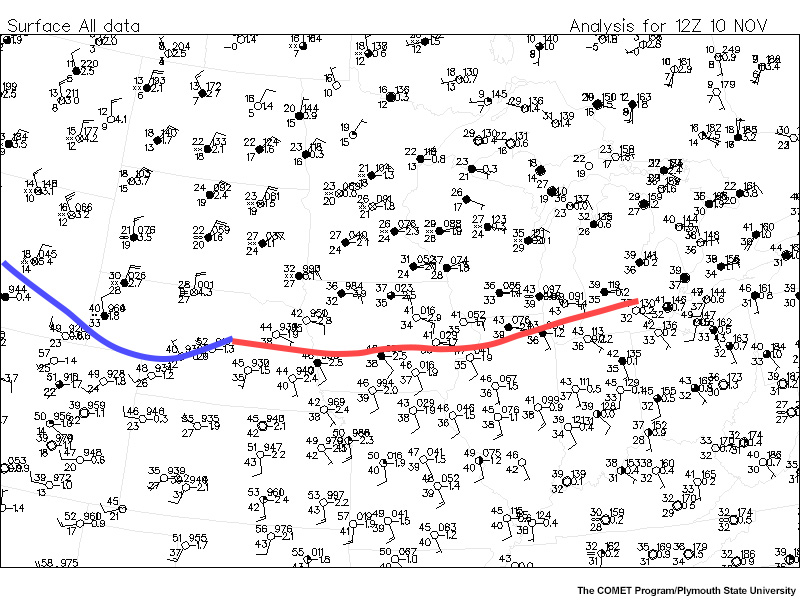Introduction
Introduction » What is a Front?
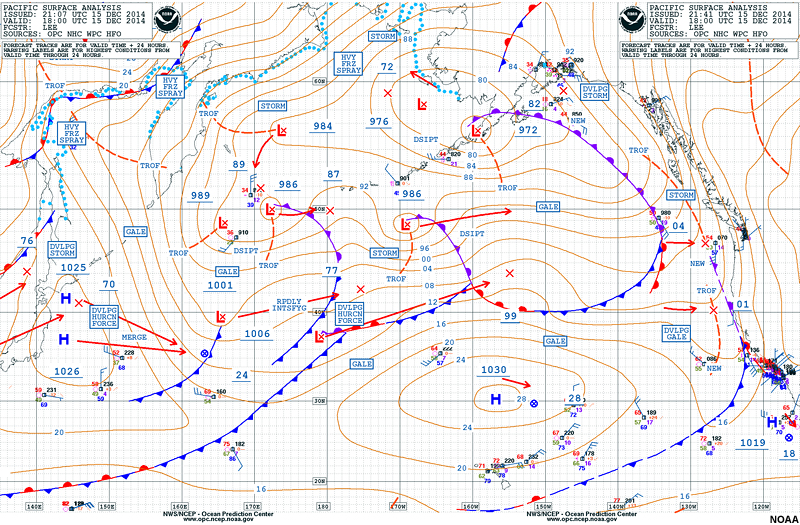
Although fronts are a ubiquitous feature on surface weather charts both for hydrometeorologist professionals and the public alike, there is still not a universally accepted definition of what constitutes a front, especially where analysis of fronts on charts is concerned.
Some meteorologists and researchers have argued for a specific threshold to define a front, such as 8°C/220km being a “strong” synoptic-scale front or a minimum of 6°C/500km, while others have espoused the less specific definitions that entail a synoptic front being an interface and/or transition zone between airmasses of different density. Others have defined fronts as gradients or discontinuities in certain weather fields, like temperature or moisture, but not others, such as wind direction, and vice versa.
Herein we will examine both synoptic scale and mesoscale fronts, and treat them as weather features possessing the following qualities or characteristics:
A sharp gradient and/or discontinuity of a weather field, primarily temperature or potential temperature, that is generally attributable to airmass boundaries in and near systems that cause such airmasses to move on the order of at least several hours. Shallow, semipermanent thermal gradients that are locked in place by land-water or other topographic influences will generally be excluded in analyses here, except where they become ingested into the movement of a passing synoptic-scale or in rarer cases, mesoscale, system.
We will not attempt to explain the thermodynamic theory or dynamic theory of frontal types, frontogenesis, or frontolysis in detail here, but simply the analysis of their existence and placement on maps, as well as the diagnosis of their type.
Note: The remainder of this module contains interactive drawing tools that are optimized for google chrome, firefox and safari - internet explorer/edge users may want to switch browsers.
Introduction » Utility of Frontal Analysis in Modern Forecasting
Frontal analysis in modern forecasting is still a critical part of a forecaster’s toolkit, and not just because fronts are often associated with precipitation. Fronts can strongly impact local weather conditions via wind changes, convective forcing, turbulence and more. While many computer-based weather visualization packages can identify frontal zones on the large scale, they usually lack nuance in positioning of the front on the regional and local scales, which poses issues for short-range forecasting of all kinds, especially aviation.
Additionally, a thorough examination of surface observations to create a hand-analysis of surface pressure systems and fronts, even if not truly completed “by hand” and instead in a 3D mental model space, allows the forecaster to become intimately familiar with the current weather in a way that examining a computer frontal analysis cannot. Situational awareness is gained, as well as conceptual awareness of synoptic processes, mesoscale processes, storm-scale processes and topographic influences that are interacting to create the “wiggles” one sometimes sees in a front’s position. These wiggles, or surges, can be caused by outflow from an MCS merging with the larger synoptic scale cold front, are sometimes powered by a secondary push of cold air that has mixed down from upper levels, and for other reasons. Although it takes more time up front in the forecast process, the knowledge gained from this analysis process often makes the rest of the forecast process go much faster - many extraneous pressure level charts of basic state variables can be skipped and the forecaster can go directly to regional and local scale variables of interest to address the forecast problems of day.
Introduction » Review of Frontal Types and Identification Conventions
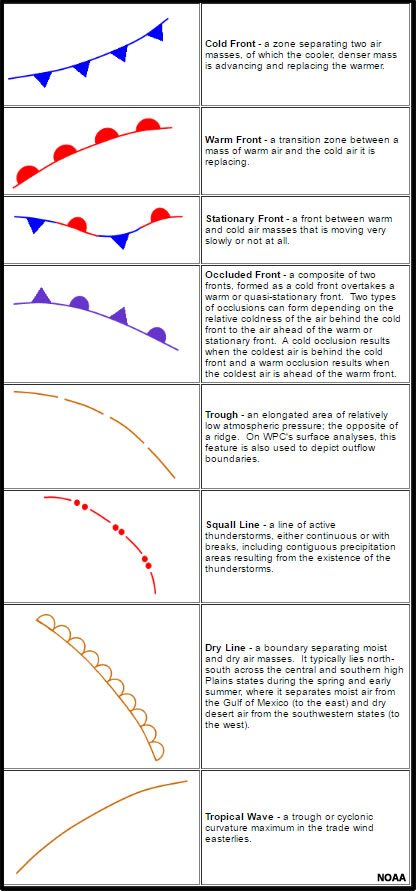
In a standard surface analysis you may find 4 main types of synoptic scale fronts, plus a front tied to local topography and land type, as well as other symbols to indicate common meso/local scale features of interest and pressure-related features.
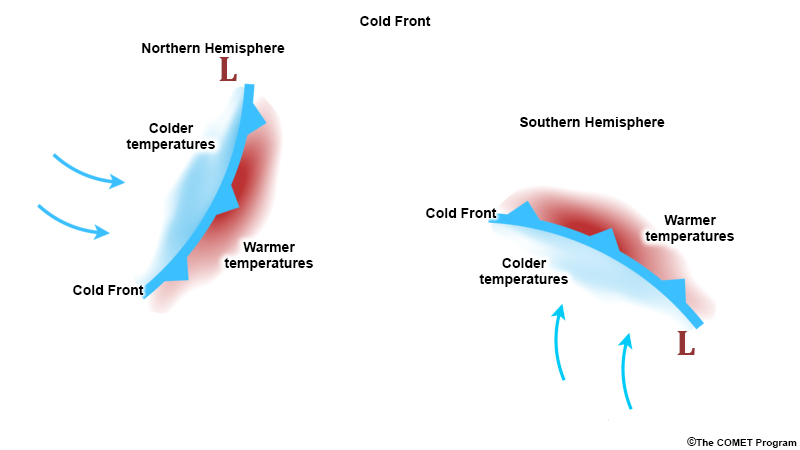
Cold fronts are typically analyzed at the leading edge of a density discontinuity ahead of a cooler/colder airmass. Cold frontal zones tend to be narrower than warm fronts because the trailing airmass is normally of higher density and thus helps drive forward motion. They are analyzed as a blue line with solid blue triangles pointing toward the warmer airmass. Typically air behind the front will possess lower temperatures, lower dewpoint temperatures and winds will have westerly component (in midlatitudes)
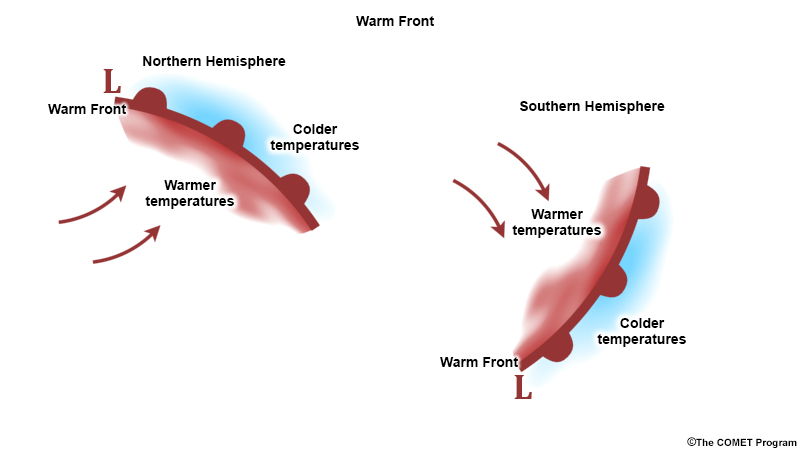
Warm fronts are typically analyzed at the equatorward edge of a density discontinuity behind a retreating and modified cooler airmass. Warm frontal zones tend to be broader than cold frontal zones because the denser airmass ahead of the front erodes slowly. Warm fronts are analyzed as a red line with solid red semicircles that face into the warmer airmass. Typically air behind the front will possess warmer temperatures, higher dewpoint temperatures and winds will have southerly component (in midlatitudes).
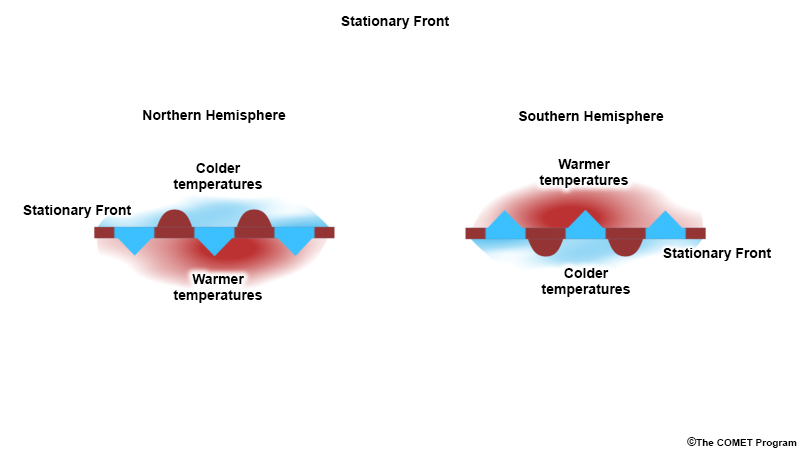
Stationary fronts are typically analyzed at the equatorward edge of a stationary or very slow moving density discontinuity. Stationary frontal zones tend to be narrower than warm frontal zones, but broader than that for most cold fronts, because the boundary is not moving but may have flow that is parallel to slightly frontogenetic. A common synoptic setup for stationary front development includes mature to decaying cold fronts that stall after the main cyclone has passed, sometimes in conjunction with weak to moderate flow into the area from an anticyclone.
Topography also causes many stationary fronts to be analyzed at particular locations, such as when a cold front pushes southwestward into the Rocky Mountains in Colorado, Wyoming and New Mexico, or similarly when cold air becomes “dammed” at low levels in the Appalachian mountains.
Stationary fronts are analyzed as alternating red semicircles and blue triangles as seen above. Typically, air on the cooler side of the stationary front will have lower dewpoint temperatures and flow roughly parallel to the front, while air on the warmer side will have higher dewpoints, a southerly component and flow either parallel to the frontal zone, or toward it. Occasionally, extended areas of directly opposing flow will intensify and strengthen a stationary front.
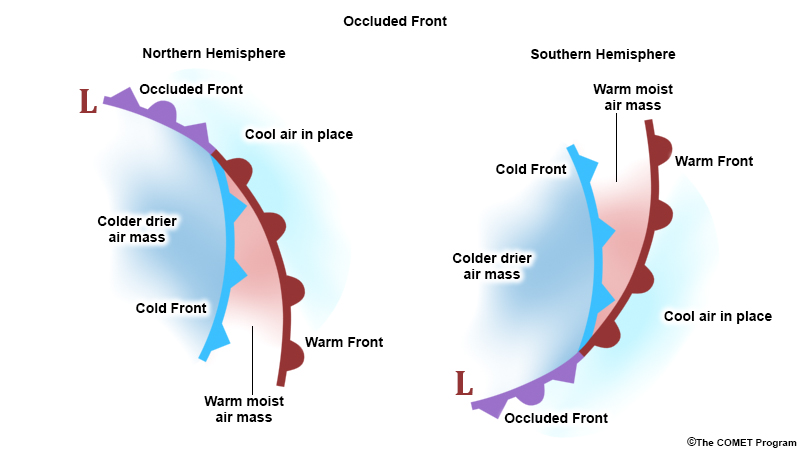
Occluded fronts are typically analyzed in the late stages of cyclone development when the coldest air associated with a cyclone is still well behind the cold front but the leading edge of cold air has advanced enough to displace the cooler air poleward of the warm, moist airmass (cold occlusion). Situations in which the coldest air associated with a cyclone is instead found poleward of the warm, moist airmass results in pushing the cold front aloft (warm occlusion).
Occluded fronts are analyzed using purple line with alternating solid purple semicircles and triangles. Typically air behind the occluded front will possess colder temperatures, lower dewpoint temperatures and winds will have westerly component while air directly ahead of the occluded front will be cool, have slightly higher dewpoints, and come from an easterly and/or southeasterly direction - the warmest, moistest airmass will be cutoff and to the south of the low pressure center, with generally southerly winds.
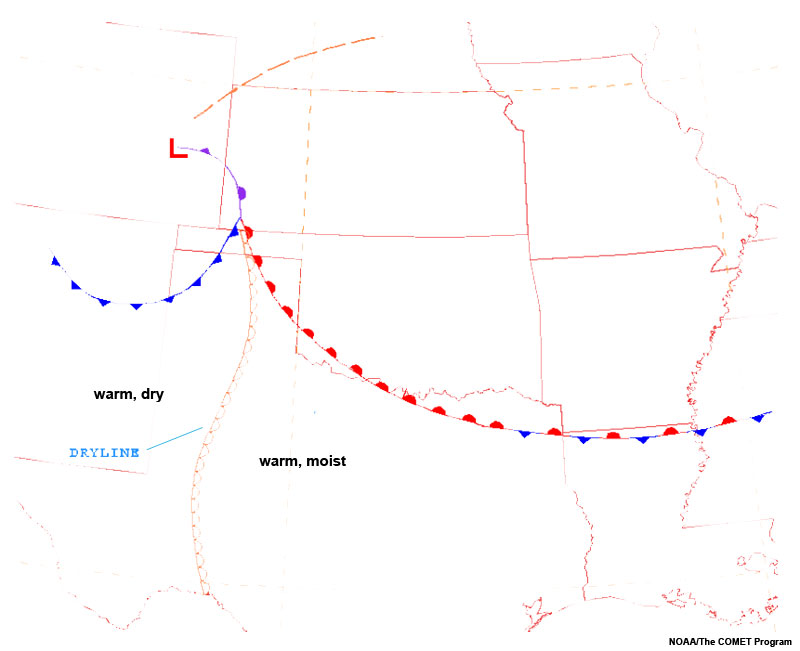
Drylines are typically analyzed at the leading edge of a strong density (moisture) discontinuity forced by downslope winds off the Rockies into the southern plains, often in conjunction with lee cyclogenesis. Drylines usually advance eastward during peak diurnal heating and retreat westward in the overnight hours. Drylines typically possess a strong dewpoint gradient that can approach a 30°F difference over 200km, and sometimes can approach 50°F differences in narrow zones. Drylines are often the focus of intense convection during the springtime months. Drylines are analyzed as a brown line with scallops facing toward the moist airmass.
Pre-Lab: Finding Fronts - Or Not! - using Single Fields
Traditionally, forecasters relied on one or more of the following fields to help define the location of a surface front: temperature, moisture, wind speed and especially direction, pressure or pressure change, and cloud cover and associated significant precipitation.
While the signatures and information discussed for each of these fields can most certainly be found in association with various types of fronts or at certain times along various fronts, the discerning forecaster should note that when used individually, these guidelines alone do not define a front! Nor are they unique to a specific type of front in a specific pattern.
Here, we cover some of the common patterns in fields available on maps of surface observations that can help you analyze and diagnose frontal position and type. In the subsequent section, we will combine these fields, as well as other observations, in order to fully determine frontal type, position and evolution.
Temperature & Potential Temperature
Surface temperature and/or potential temperature should generally be the primary determiner of frontal type and position, especially for large-scale, synoptic fronts in the midlatitudes.
To use temperature to help determine frontal type and location, one can work with surface station model plots or temperature contours of the station model plot.
Areas of significant temperature gradient should be analyzed, and their position relative to associated low pressure system, topography, etc, should be noted.
The position of the front with respect to which side of the gradient it is drawn upon will depend upon the type of front - but generally, a rule of thumb is to draw it on the warm edge of the gradient. This works for cold, warm and stationary fronts.
Question 1 of 6
Examine the following map of contoured surface temperature. Draw in the location of the main surface frontal zone using the pen tool. Be sure to choose the suggested color of the pen shown by clicking on the given colored circle in each of the following drawing questions.

| Tool: | Tool Size: | Color: |
|---|---|---|
Here we can identify a distinct zone of strong temperature gradient beginning in eastern Kansas and extending south-southwestward through central Oklahoma and western Texas. Although right now we don’t yet know what type of front exists here, we can follow the general rule that the front will be analyzed on the warm side of the gradient. An analyzed, drawn answer will appear after the question series.
Moisture
To use moisture readings to help determine frontal type and location, it is easy to work with dewpoint on surface station model plots or isodrosotherms of the station model plot.
Areas of significant dewpoint gradient should be analyzed, and their position relative to associated low pressure system, topography, etc, should be noted.
The position of the front with respect to which side of the gradient it is drawn on will depend upon the type of front - but generally, a rule of thumb is to draw it near the moist edge of the gradient. This works for cold, warm, and stationary fronts as well as drylines.
Question 2 of 6
Examine the following map of contoured dewpoint temperature. Draw in the location of the main surface frontal zone as you did in the previous map.
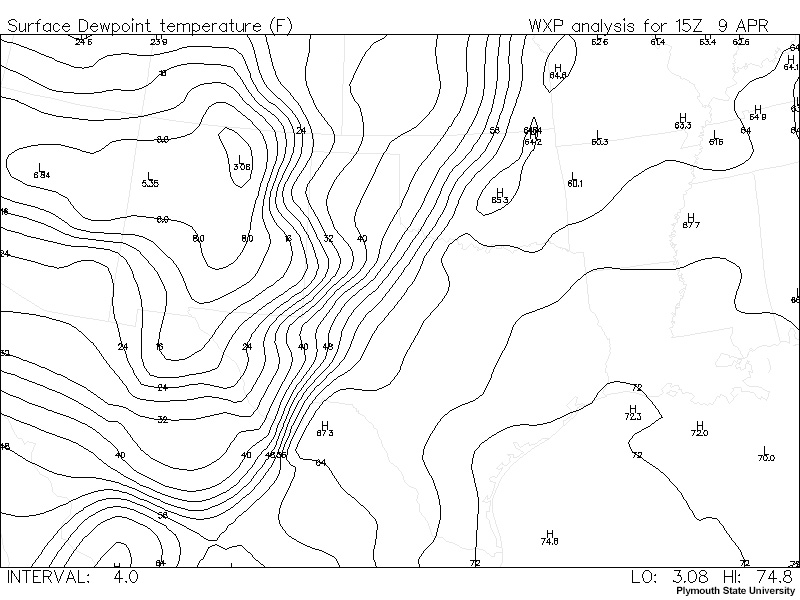
| Tool: | Tool Size: | Color: |
|---|---|---|
Here again we can identify the main frontal zone where isodrosotherms are tightly packed, beginning in eastern Kansas, extending into central Oklahoma, and then extending to western Texas. We can see that the moisture gradient remains intense even into Mexico, unlike the previous temperature map in which the temperature gradient was no longer pronounced that far south.
Winds
To use wind speed and direction to analyze frontal location, one could use wind vectors, but it is probably easiest for to use wind barbs on standard station model plot maps. The barbs provide increased accuracy in wind speed as compared to estimating vector magnitude visually by comparison to a unit vector in the key/legend.
Major synoptic-scale fronts typically exhibit a sharp change in wind direction directly at the frontal location (sometimes reminiscent of the wind change you experience as the gust front of a thunderstorm passes through). Examining wind direction also helps reinforce the user’s mental models of airmass travel and streamflow. Other fronts, such as the dryline, show a more subtle wind shift, but it is usually consistent across a large area, nonetheless.
The front should be drawn between the two areas that have large swaths of winds consistently from the same direction.
Question 3 of 6
Examine the following map of surface wind barbs. Draw in the location of the main surface frontal zone.
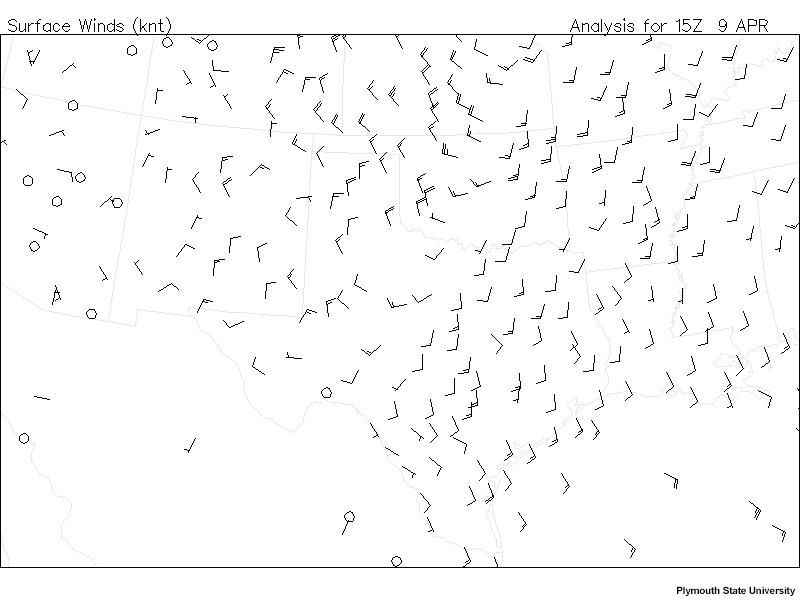
| Tool: | Tool Size: | Color: |
|---|---|---|
Here we can identify a zone of significant shift in wind direction, again in roughly the same region as the previous temperature and moisture gradients.
Pressure
Pressure can also be used to analyze fronts, as theory suggests that a first-order discontinuity in pressure should accompany a discontinuity in temperature where the front slopes upward toward cooler air. Thus, isobars crossing a front should display a kink for sharp boundaries.
In practice we don’t often see true first-order discontinuities, but rather extended zones of strong temperature gradients; thus an isobar crossing a front should be curved slightly and the front will generally be found within a slight trough (or a flat spot within a ridge). Occasionally, one will see a trough in surface pressure extended outward just along and ahead of a front due to strong low-level lifting associated with convection.
On a map, these pressure troughs in association with fronts can look like the troughs around the cold and stationary fronts extending away from the low here:
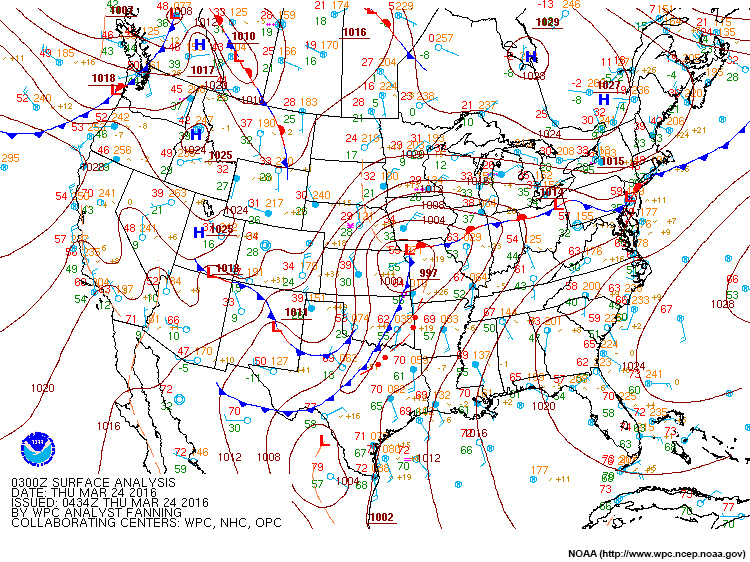
Question 4 of 6
Examine the following map of isobars. Draw in the location of the main frontal zone.
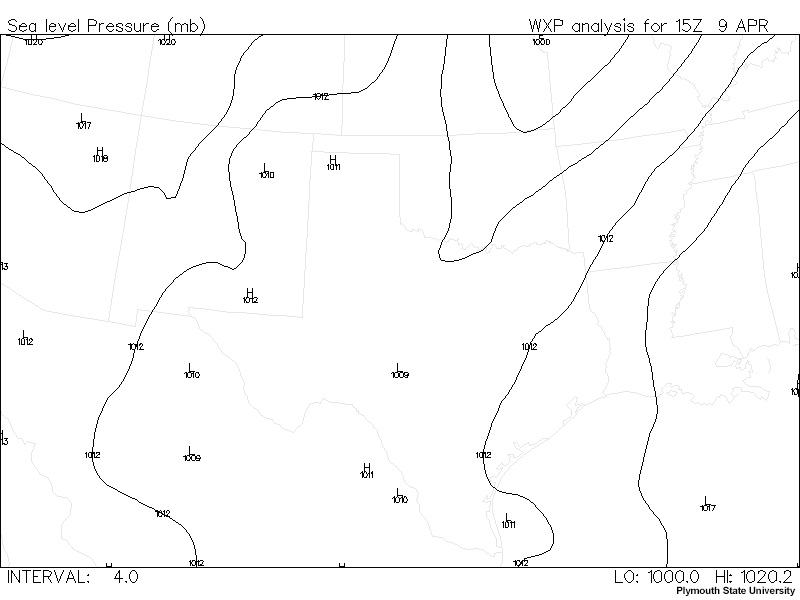
| Tool: | Tool Size: | Color: |
|---|---|---|
Here we can identify one distinct surface pressure trough, which roughly aligns with the temperature and moisture gradients identified earlier, extending through central Oklahoma and just into Texas.
Cloud Cover & Significant Weather
Cloud cover and significant weather are often cited as important indicator of frontal position, and quite often they are. But to identify frontal location solely from either of these two variables can be a guessing game. In the example below, a band of thick cloud cover and a line of convection are present along the cold front, giving away surface frontal position with a fair amount of accuracy even from space. However, what about the warm front? It doesn’t appear to have distinguishing cloud and precipitation features like the cold front - in fact, there is a very large cloud shield that covers not just the warm front, but the occluded front, northern portions of the cold front, and areas well behind the cyclone center.
This is but one of many examples. Other factors that preclude cloud cover and significant weather from being used on an individual basis to identify surface fronts include the presence of clouds and precipitation due to upper level fronts and the trowal, areas of fog, and topographically-forced precipitation and clouds away from fronts.
Let’s take a look at the frontal zone we were identifying earlier and see how the significant weather and cloud cover shape up over that area. Examine the following map of cloud cover observations.
Question 5 of 6
Draw in the location of the main frontal zone based on cloud cover.
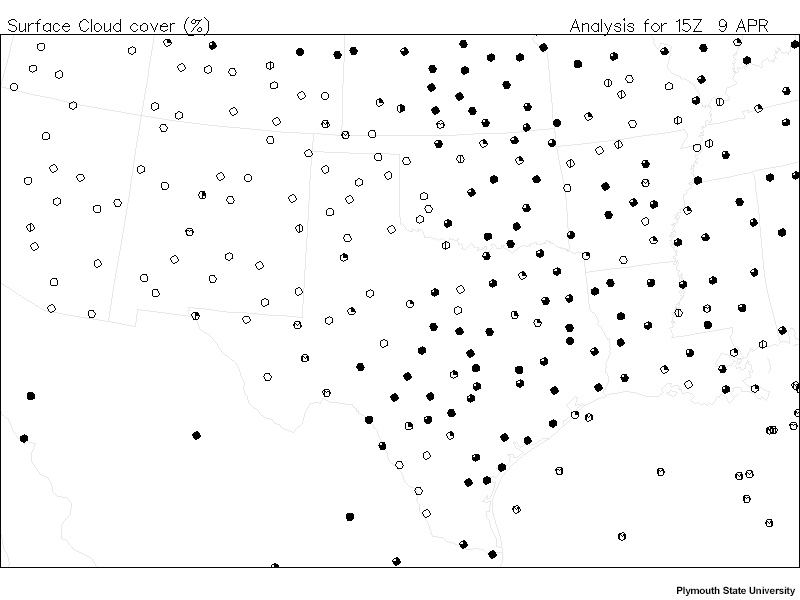
| Tool: | Tool Size: | Color: |
|---|---|---|
Here partly cloudy to overcast conditions are present along the frontal zone we identified earlier, but they extend well to the east and south of the zone itself.
Now let’s look at significant weather. Examine the following map of present weather observations.
Question 6 of 6
Draw in the location of the main frontal zone based on these observations.
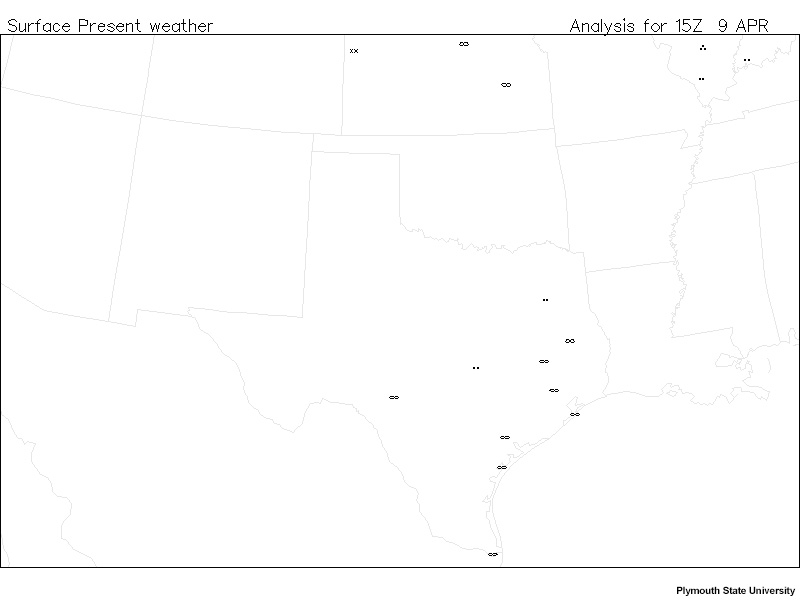
| Tool: | Tool Size: | Color: |
|---|---|---|
While one would reasonably expect some precipitation along and or just ahead of the frontal zone we identified, especially given all that cloud cover, the only significant weather we see here is haze or light rain, which is mostly coastal in SE Texas. Precipitable water, dryness of the lower troposphere (and potential evaporation/virga) all play a role in determining whether a given front will produce precipitation or not.
All Variables Together
Now that we’ve drawn in the rough location of the frontal zone, let’s take a look at all the front drawings from earlier together:
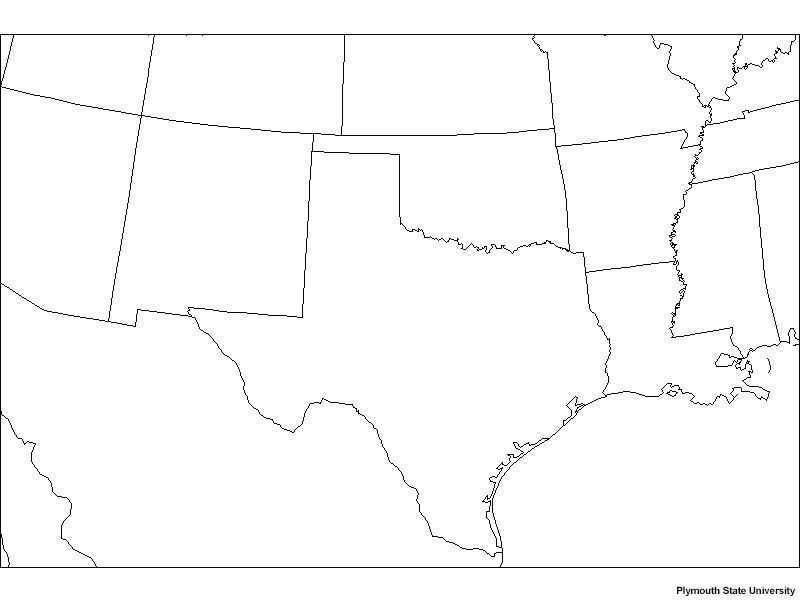
While we can see that many of the variables produced a frontal zone very close to each other, some variables were not particularly useful in this regard, especially cloud cover and significant weather. Even isotherms and isodrosotherm gradients do not necessarily outline the location of a front in exactly the same spot.
While contoured maps like the ones presented here can help train the eye on zones of strong temperature or moisture gradients, as well as pressure troughs, it is clear that we need to use all of these variables together to truly pinpoint the location of a front. Often after some “getting used to”, we can use a map of station plots to see all of these variables together and refine the frontal location.
Question 1 of 1
Determine the final location of the surface front by drawing it in with the pen tool. Available colors correspond to the standard color schemes mentioned above.
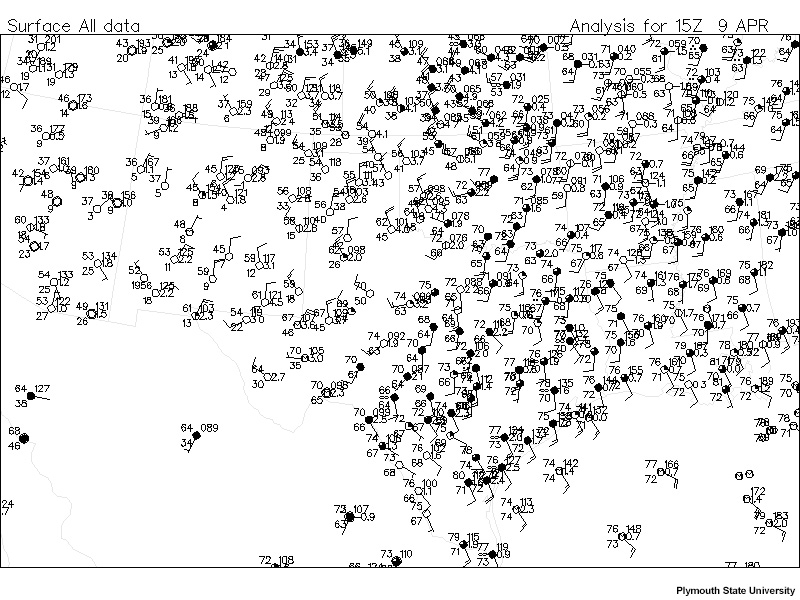
| Tool: | Tool Size: | Color: |
|---|---|---|
Now we can see the temperature and moisture gradients together, along with pressure and importantly, winds. The cold front is analyzed beginning in eastern kansas, extending through central Oklahoma and into western Texas, as before, but we can now pinpoint the location more accurately because winds are on the same map - the warm, moist flow to the east is separated from the dry, cool flow to the west by using the wind shift from southeasterly to northwesterly. The front can be drawn between the easterly component winds and westerly component ones along the line of convergence.
Pre-Lab: Finding Fronts using Multiple Fields
Pre-Lab: Finding Fronts using Multiple Fields » Putting it All Together: Practice Examples with Station Observations
While we have covered several of the most common indicators of fronts, it should be noted that for nearly all frontal types, examining surface temperature contours, or preferably those of surface potential temperature, should generally be given the most weight and performed first - the other fields can then be used to further refine the frontal zone to a singular location.
Now, we’ll practice on some examples of each frontal type using station plots.
Pre-Lab: Finding Fronts using Multiple Fields » Putting it All Together: Practice Examples with Station Observations » Cold Front
Example 2
We’ve already seen a cold front in the earlier examples. Here’s another one.
Question 1 of 1
Determine the location of any surface fronts by drawing them in with the pen tool(s). Available colors correspond to the standard color schemes mentioned in the introduction.
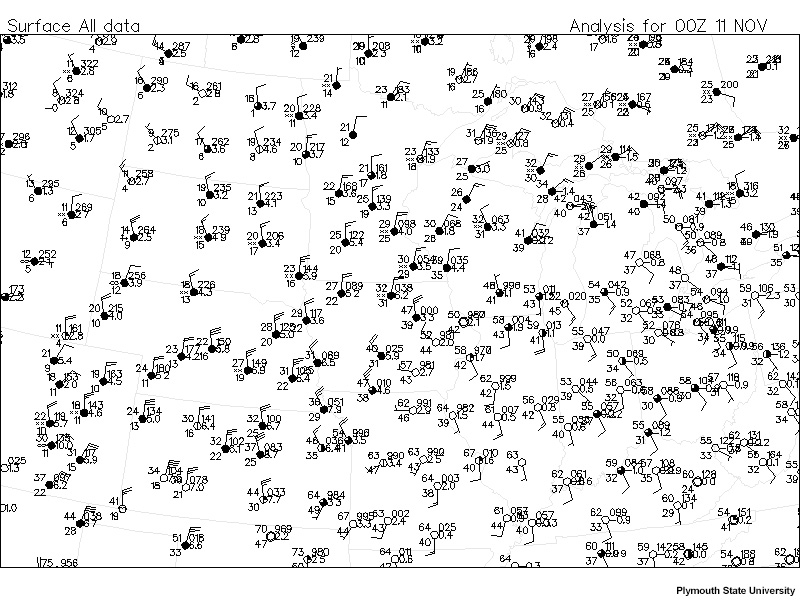
| Tool: | Tool Size: | Color: |
|---|---|---|
Here we can see a distinct temperature gradient running southwest to northeast across eastern Kansas over the IL-IA border and northward into MI, which coincides with a very significant wind shift. We can draw in the front beginning near the center of low pressure, which is identified by counterclockwise flow and a minimum in pressure near Davenport, IA. The front extends southwestward, separating the cold, dry air coming from the northwest from the much warmer, more moist air and light to southerly winds to the south and east. More dense observations would, of course, allow us to pinpoint the frontal location further. Here the front was drawn in this exact position taking into account temperature and moisture modification (areas in which the colder air is just arriving may have been quite warm and the cold air takes a bit to mix with the warmer air, thus not reflecting as cold of temperatures as you might expect with a true discontinuity. Additionally, the station may not report fully northwesterly winds yet, as the core of northwesterly or westerly flow often lies behind a pronounced axis of dilatation in which winds curve more counterclockwise (nearer the low) and more clockwise (near far end of cold front).
Pre-Lab: Finding Fronts using Multiple Fields » Putting it All Together: Practice Examples with Station Observations » Warm Front
Example
Question 1 of 2
Determine the location of any surface fronts by drawing them in with the pen tool(s). Available colors correspond to the standard color schemes mentioned above.
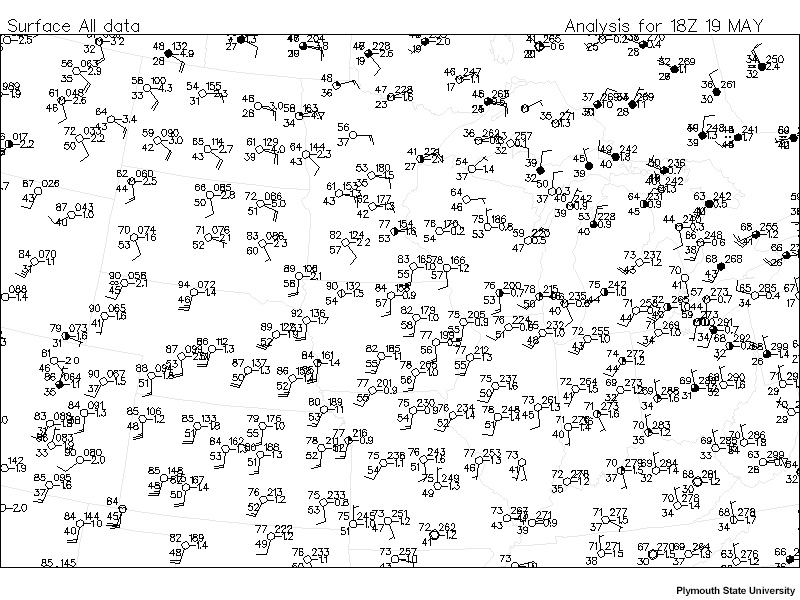
| Tool: | Tool Size: | Color: |
|---|---|---|
A quick glance at pressures and winds overall tells us there must be a low pressure system centered off the page close to the northwest corner of the region. Given that information, and the very wide swaths of warm temperatures in the 80s with dewpoints in the 50s and southerly winds across the great plains, we can guess that a frontal boundary separates the northern edge from the cooler, less moist easterlies across the states bordering with Canada. The warm front runs roughly from the intersection of MT, WY and SD southeastward through southern SD, eastward and northeastward into the Minneapolis area, and then through central WI - further east than this the boundary may be stationary, given the more variable and lighter winds. We will cover situational awareness and determining frontal type via animations in a subsequent section of the pre-labs.
Example 2
Question 2 of 2
Determine the location of any surface fronts by drawing them in with the pen tool(s). Available colors correspond to the standard color schemes mentioned above.
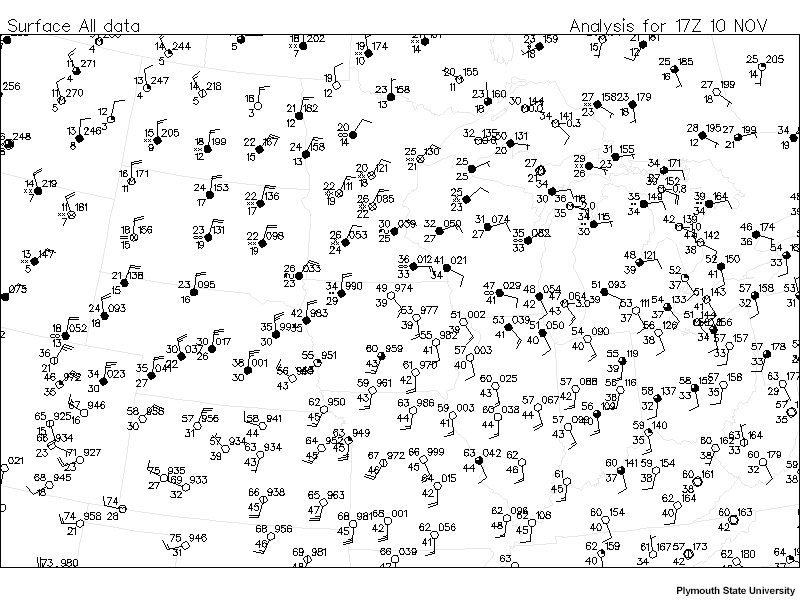
| Tool: | Tool Size: | Color: |
|---|---|---|
Here we can see a developing low pressure system situated roughly over western Iowa. A cold, dry airmass lies to its west and just slightly south of west into northern Kansas. A warm, moist airmass with temperatures in the 60s and 50s and dewpoints in the mid-40s coming from the south stretches across much of Kansas, all of Missouri, nearly all of Illinois and into Indiana. The warm front denotes the boundary between this muggy air and the much cooler, modified dry air coming from primarily from the east that is draped across central and northern Wisconsin, central and northern Michigan and extending eastward north of Lake Erie and Lake Ontario.
Pre-Lab: Finding Fronts using Multiple Fields » Putting it All Together: Practice Examples with Station Observations » Stationary Front
Question 1 of 1
Determine the location of any surface fronts by drawing them in with the pen tool(s). Available colors correspond to the standard color schemes mentioned above.
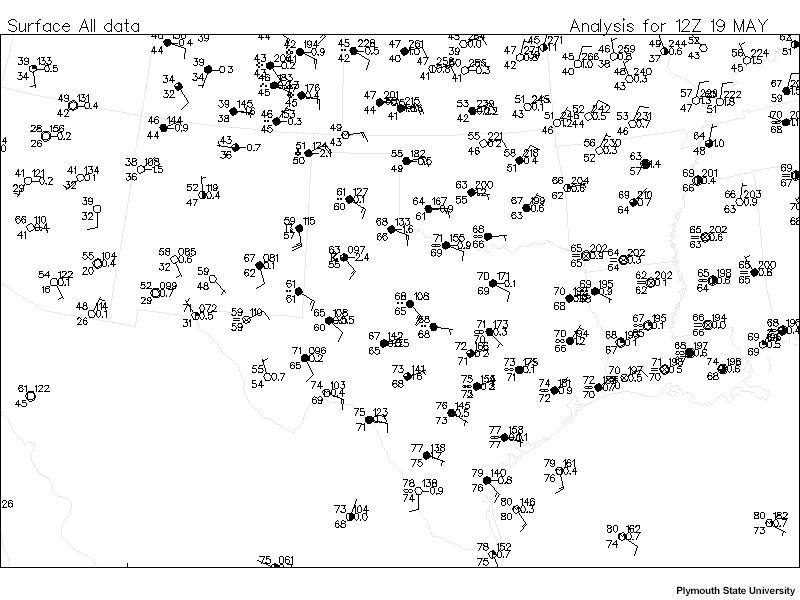
| Tool: | Tool Size: | Color: |
|---|---|---|
Here we’ve already stated that a stationary front is present - however, if one were looking it only this map at a single time it may be difficult to determine what type the front is, as the boundary could be moving significantly over time. The wind speeds are slightly stronger on the south side of the boundary (10-15 knots across central Texas), and are coming into the frontal zone at a similar angle to the 5 to 10 knot winds across Missouri, Oklahoma and Kansas - one might guess this is a warm front.
As we glance across the map we can see a broad area of warm (60s) and moist (also 60s) southeasterly flow across most of Texas and Louisiana. To the north, we see a broad area of norhteasterly or easterly flow, with temperatures in the 40s or 50s and dewpoints around the same values. The stationary front is the boundary between these airmasses, and runs roughly from western Kentucky west-southwestward into northern Arkansas, westward through south-central Oklahoma, and then curves northward and westward into the Texas panhandle before encountering the Rocky Mountains in New Mexico.
Pre-Lab: Finding Fronts using Multiple Fields » Putting it All Together: Practice Examples with Station Observations » Occluded Front
Example 1
Question 1 of 1
Determine the location of any surface fronts by drawing them in with the pen tool(s). Available colors correspond to the standard color schemes mentioned above.
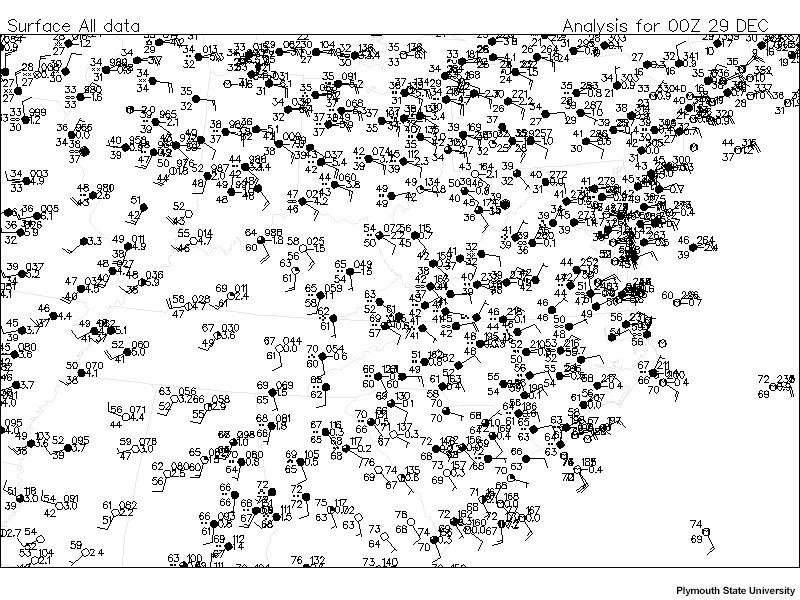
| Tool: | Tool Size: | Color: |
|---|---|---|
From the flow pattern and pressure readings we can tell that a low is centered over west-central Illinois. To the south and west of the low, cold air with temperatures in the upper 30s and 40s, with dewpoints in the upper 30s and low 40s flows from the west and into Mississippi, eastern Tennessee and Kentucky and into southwest Indiana, where some is wrapping back in toward the north and west near the center of the low. This cold, dry airmass is separated by the occluded front from the cold, modified airmass with easterly winds that prevails across central and northern Indiana and Ohio. A warm front trails from southern Indiana through northeast Kentucky, and across south-central North Carolina - the airmass south of the boundary is easily identifiable by much warmer temperatures in the 60s and low 70s, dewpoints in the 60s, and wind from the south or southeast.
Pre-Lab: Finding Fronts using Multiple Fields » Putting it All Together: Practice Examples with Station Observations » Dryline
Example 1
Question 1 of 2
Determine the location of any surface fronts by drawing them in with the pen tool(s). Available colors correspond to the standard color schemes mentioned above.
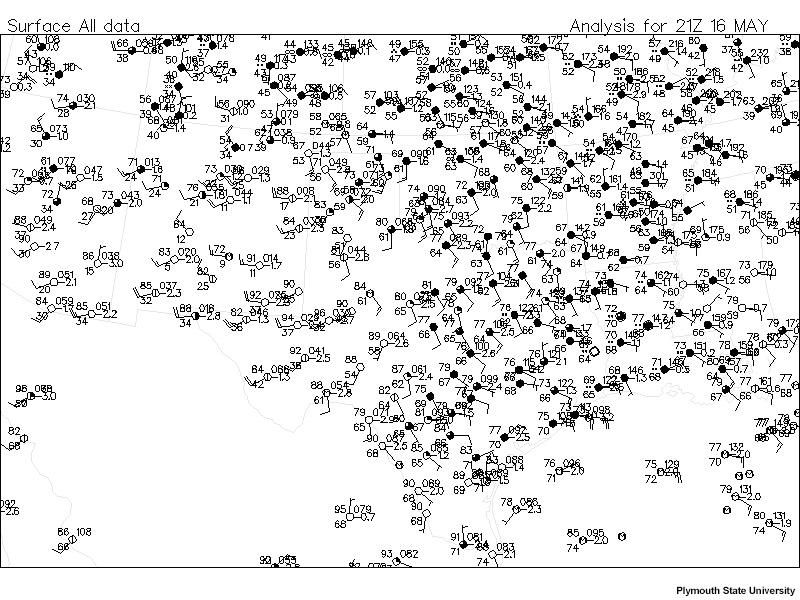
| Tool: | Tool Size: | Color: |
|---|---|---|
While a temperature gradient is present in western Texas (slightly warmer to the west), the dewpoint gradient is pronounced - dewpoints in the lower to mid 60s are reported near Lubbock and Amarillo, while just across the border into New Mexico the dewpoints dip into the teens. The dryline marks the leading edge of much drier and warmer downsloping air that is mixing into the plains - it begins just west of the border of NM and the panhandles, and extends southward, then southeastward back into north-central TX, before curving slightly westward again and then moving eastward significantly, bending around the Midland-Odessa area, before trailing south-southwesterly again just west of Del Rio.
Drylines can advance quickly to the east during the day and retreat quickly during the overnight hours, so one may observe significant changes in their position on hourly surface observations plots. Again, situational awareness is critical, especially when severe convection is expected.
Example 2
Let’s look at another example to highlight the various shapes of drylines (which are tied to local topography and prevailing synoptic-scale mid-level winds)
Question 2 of 2
Determine the location of any surface fronts by drawing them in with the pen tool(s). Available colors correspond to the standard color schemes mentioned above.
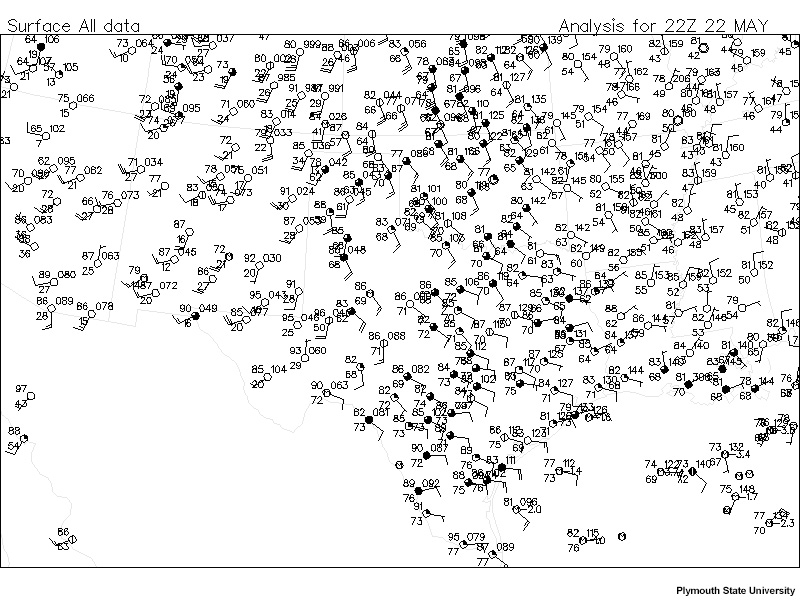
| Tool: | Tool Size: | Color: |
|---|---|---|
This dryline extends further north than in the previous example. From the flow pattern we can guess that a low pressure center is present off the center of the page to the north. From there, we can see temperatures in eastern Colorado are in the upper 80s or so with dewpoint temperatures in the 20s, with widespread winds coming from the south-southwest. Contrastingly, winds in eastern Kansas are from the south-southeast, with dewpoints in the mid 60s and temperatures in the mid 80s - the dryline separates these two airmasses as shown, and extends southward into the very far western Oklahoma and Texas panhandles, southward just east of the Texas-New Mexico Border and then toward Del Rio, Texas.
Pre-Lab: Finding Fronts using Multiple Fields » Importance of 4th Dimension and Situational Awareness
As mentioned in some of the earlier practice analysis feedback/answers, situational awareness is critical to performing a comprehensive and accurate frontal analysis. This is especially true for fast-moving fronts, like cold fronts or drylines, as well as fronts that are changing type (e.g., cold fronts or warm fronts stalling and becoming stationary, or vice versa). Without examining prior maps over several hours we often cannot truly tell what kind of front we should analyze at a density gradient. Let’s investigate the usefulness of examining previous frontal analyses other observations in the next two examples.
Pre-Lab: Finding Fronts using Multiple Fields » Importance of 4th Dimension and Situational Awareness » Example 1
Question 1 of 1
Determine the location of any surface fronts by drawing them in with the pen tool(s). Available colors correspond to the standard color schemes mentioned above.
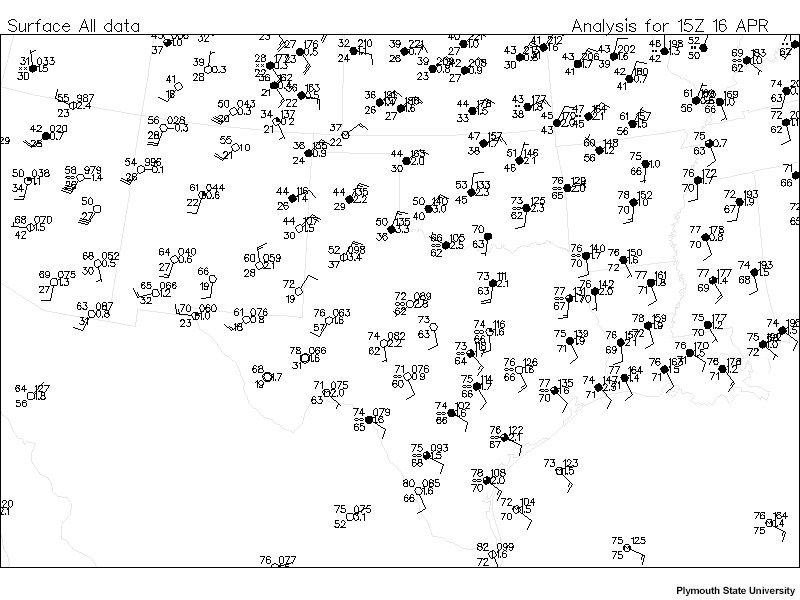
| Tool: | Tool Size: | Color: |
|---|---|---|
Here winds are approximately 10 to 15 knots on each side of a front and they oppose each other in direction - it is impossible to tell from this single map which way the front is moving (or not moving!). Thus, situational awareness is invaluable.
The flow and weak pressure trough through ArkLaTex into the MS and Ohio River confluence area suggests that perhaps a large cold front probably moved through and is weakening or stalling. There are two distinct airmasses - one that is cold, with air in the 30s-40s, dewpoints in the mid twenties to forty-ish neighborhood, and winds from the northeast, and another with warm temperatures in the 70s, dewpoints in the 60s and low 70s, and winds from the south or southeast. The frontal zone is the boundary between these two airmasses, and runs from the St. Louis area west-southwestward through central Oklahoma, into northern Texas and finishes in southeastern New Mexico - beyond that we cannot exactly determine the frontal location due to topographic influences (and sparse data).
Let’s look at an animation of previous surface analyses leading up to the time of the station plots:
We can see that only a few hours earlier the frontal boundary was moving much more quickly, being analyzed as a cold front, and only became stationary very recently.
Pre-Lab: Finding Fronts using Multiple Fields » Importance of 4th Dimension and Situational Awareness » Example 2
Question 2 of 2
Determine the location of any surface fronts by drawing them in with the pen tool(s). Available colors correspond to the standard color schemes mentioned above.
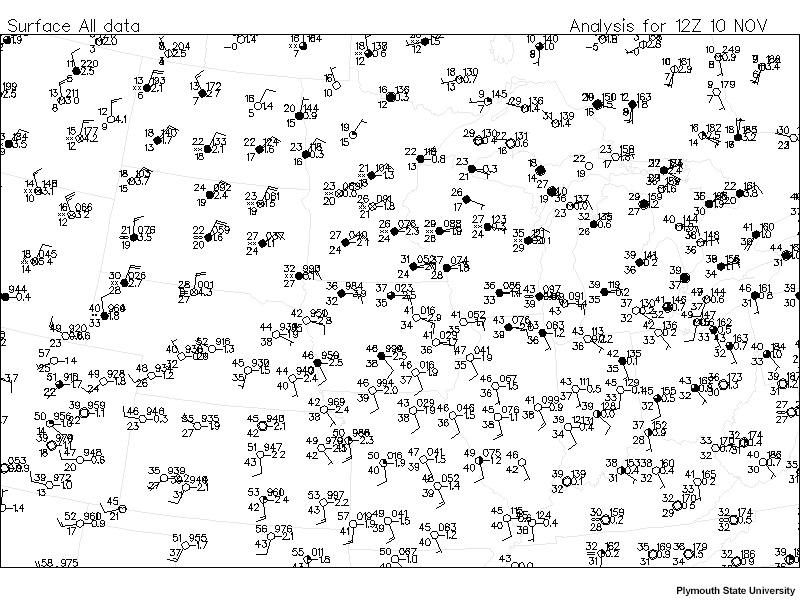
| Tool: | Tool Size: | Color: |
|---|---|---|
Here we can see a weak and broad lee cyclone taking shape over Nebraska. A warm and moist airmass with temperatures in the 40s, dewpoints in the upper 30s and low 40s and winds from the south-southeast stretches across southern Iowa, most of Illinois, Missouri and eastern Kansas. A cooler, slightly drier airmass exists to the north of these areas, with winds coming from the east. Much colder and drier air exists behind and northwest of the low.
While we might guess that we have a developing warm front and a stationary front to the west, we actually have a cold front to the west and a warm front to the east. However, if we look again backwards a few hours, we see that neither one of these fronts has been moving significantly for long. Without examining this previous data it is tricky to identify the type of these two fronts for sure.
Pre-Lab: Finding Fronts using Multiple Fields » Supporting Observations: Radar, Satellite and Other Fields
As we saw earlier, using surface observation plots is a relatively comprehensive way of detailing the positions of surface fronts. However, frontal location can be pinpointed even more accurately with assistance of radar and satellite data. The resolution of such products is much higher than station plots, which are often spaced sparsely, being tens of miles apart. Additionally, many reporting stations only report hourly, and those that report more frequently sometimes do not get pulled into standard hourly maps, while radars scan low levels approximately every 5 minutes and geostationary satellite data is updated every 15 minutes (soon to be 1 to 5 minutes with GOES-R).
Timely and detailed frontal positioning information can be critical during short-term forecasts of severe convection, high winds, mixed precipitation and is thus especially important to industries like aviation.
Here we will see a couple examples of how a synoptic-scale front can appear on radar. First, let’s look at the warm front example we analyzed earlier:
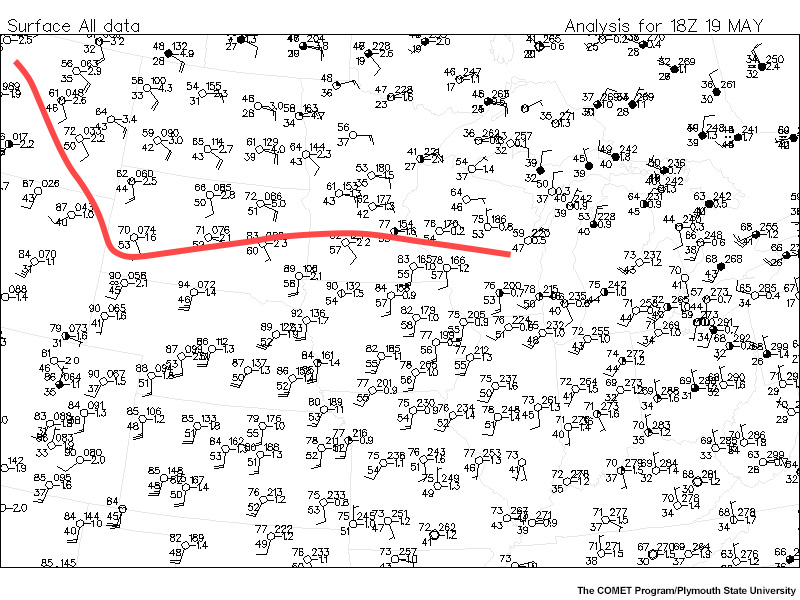
The warm front runs roughly from the intersection of MT, WY and SD southeastward through southern SD, eastward and northeastward into the Minneapolis area, and then through central WI - further east than this the boundary may be stationary, given the more variable and lighter winds.
Because the observations are relatively sparse, we could see more detail if the local radar happened to capture it well. Here’s a loop of the MPX radar base reflectivity centered on the same time as the surface analysis (Chanhanssen, Minnesota - just south and east of Minneapolis)
Another example of using local radar to help refine frontal position is below. A dryline is present as a fineline moving toward the east - and eventually initiates convection.
Finally, satellite is also an important tool to refine frontal locations and helps provide a wider perspective on frontal locations within cyclones. While we saw earlier that cloud cover itself often does not align with frontal locations, and is usually more widespread, certain types of cloud patterns on visible and infrared imagery, such as thin lines of very thick clouds along cold fronts, can help determine frontal location. Furthermore, water vapor imagery can be used to help diagnose both surface and upper level fronts, as seen in the loop below.
Two distinct lines of convection develop throughout the course of the animation - one along and just ahead of the first cold front (which in this case, has properties making it appear similar to a dryline - this previously cooler air came from the Pacific but has been modified by downsloping, warm ground and solar insolation), and another along a secondary cold front that trails it. In the water vapor image we can see two distinct deformation zones that align with these convective features. Much drier air is present at low-mid levels behind the second deformation zone especially. In the radar image, we can even see evidence of the location of the secondary cold front in clear air across several stations near the panhandles of Texas and Oklahoma, and stretching eastward slightly into Kansas and westward just into New Mexico - this fineline is most pronounced at 20Z and looks like an thin arc of light blue/gray pushing southward over time.
Lab Activities
Now you should be ready to begin analyzing full CONUS maps, which are sized to be easily printed for hand analysis on 8.5 x 11 paper, or can be easily imported into your preferred drawing software.
Two cases are available for surface analysis below - case 1 is a single analysis, which should be performed for 20Z. Hourly surface observations beginning at 14Z are available for situational awareness purposes.
The second case contains 6 hours of hourly surface observation data, hourly national radar data and hourly water vapor data for situational awareness purposes. Then, three maps are available for analysis: surface observations for day 2 at 0Z, 06Z and 12Z. See your instructor to determine which case(s) you will be analyzing during class and/or assignments.
